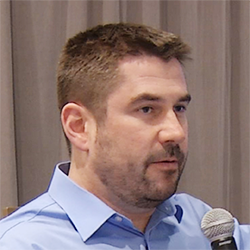Home » Coexisting Conditions » POTS: Coexisting Disorders with Amanda C. Peltier, MD, MS
POTS: Coexisting Disorders with Amanda C. Peltier, MD, MS
Video Transcript
Mr. Al Ruechel: Hi everybody I’m Al Ruechel and welcome back and we’re going to be talking in this segment about POTS and the coexisting disorders that could occur with it. Joining us right now is Doctor Amanda Peltier. Doctor thank you so much for coming by.
Dr. Amanda Peltier: Thank you for inviting me
Mr. Ruechel: Alright so let’s start out our conversation by telling me a little about yourself and the work that you’re involved in. Kind of like your bio if you would.
Dr. Peltier: Ok well so I am a neurologist who does both autonomic and peripheral nerve disorders so I started out training in neuromuscular disorders at the University of Michigan. I had a little problem because I actually did my medical school training at Ohio State and then my family called me a traitor after I did my residency and matched at the University of Michigan. But did a three-year fellowship which included a masters in clinical research design and statistical analysis and then during that Fellowship, I was actually learned about testing for autonomic disorders and looking at autonomic tests in diabetics is where I started out learning about autonomic disorders. And we were at the time looking at patients with prediabetes, so patients who did not have outright diabetes but had high cholesterol, higher range glucoses and the fact that they could have abnormal autonomic testing and abnormal testing in their nerves and could that be a potential cause of you know, neuropathy. And so, I did projects on that during my fellowship and then when I was came time to look for real job, David Robertson who was the head of the autonomic group at Vanderbilt and my chair in neurology help recruit me to Vanderbilt; and so that was back in 2005 and I’ve been at Vanderbilt ever since. And so, it has been a great time because we have a very multidisciplinary group at Vanderbilt so the autonomic group was started by David Robertson who’s a clinical pharmacologist. So, he was interested in blood pressure and looking at basically low blood pressure as opposed to you know, most people were looking at high blood pressure at the time and so he was interested both in orthostatic hypotension and also POTS and he developed a huge group and recruited a lot of people including Dr. Biaggioni, Dr. Chibao, Dr. Raj and there’s a lot of people trained at Vanderbilt and he also collaborated with a lot of people across the world. So, he has a big collaboration group with scientists from Germany, Italy, etc. So, they also did a lot of work with the astronauts and the space station doing anti-gravity work so they’ve done a whole bunch of interesting things over the years.
Mr. Ruechel: So, let’s get back to the POTS, so how does POTS tie into all of these things? Are there some other underlying conditions that occur as a result of POTS or come along with POTS, not that POTS would cause it, but whatever?
Dr. Peltier: So, they saw a lot of POTS patients over the years who were referred to the autonomic group and it was David who really liked to tell people about the fact that this is not a new syndrome it’s been going on for hundreds of years has gone by different monikers over time. So back in World War I it was called Soldier’s heart because the World War I soldiers would develop the same syndrome when they came back from the war. In the 1880s women with it were told they had neurasthenia. In my generation it was called mitral valve prolapse.
Mr. Ruechel: Which I had heard of, interesting.
Dr. Peltier: Phil Lowe coined the phrase POTS, and it’s a helpful phrase but in some ways it’s not very helpful because the POTS only talks about the high heart rate and so the problem with it is it kind of excludes all of the other stuff that comes with the syndrome. Because most of the patients that we see have more symptoms than just the high heart rate and light headedness. So that was kind of the monikure that stuck probably the longest but then the issue is that it’s a syndrome so the problem with a syndrome is it’s a collection of symptoms and signs but there can be many different causes. So, like our group you know has looked at a whole bunch of different causes and they’ve identified patients who’ve presented with POTS who’ve ended up having mast cell activation syndrome, patients who have had genetic syndromes, different autoantibodies and so they have looked for different things over the years and it’s helpful in some ways but in some ways can be somewhat challenging because looking for the individual cause is hard when there’s hundreds of possible different causes.
Mr. Ruechel: But you almost, and we know that being a doctor oftentimes involves a checklist of things you eliminate at first as you go down there, and because there’s so many things that you can’t eliminate or are not sure. So, in some of these other deficiencies then where are we right now, do you have to do all of these tests for an individual that has POTS then to figure out which of these subgroups it may be?
Dr. Peltier: Well you have to talk to the patient and listen to their symptoms, because for example not every patient is going to have significant flushing and signs of mast cell for example. Or not everybody is going to have dry mouth and dry eyes and sicca syndrome or neuropathy for example. So, it really goes back to kind of old school medicine where you actually talk to the patient and listen to them, and then test for the things that make sense and you can always add test later on but you’re trying to strike that balance of not over testing because the problem with over testing is that just by chance alone you’re going to find something abnormal and then the question is are you going to chase it down the rabbit hole and cost the patient a lot of time, effort, and money you know testing for stuff that really doesn’t make any sense or doesn’t really fit well with what their symptoms are.
Mr. Ruechel: So since you’ve been doing this for a long time have you seen progress to the point where you can say ok now reasonably speaking, these are the tests we should be concentrating on rather than having to do what I call the shotgun approach which you put a shotgun and the pellets fly all over and you try to grab each one of the pellets and you’ll be chasing pellets the rest of your life.
Dr. Peltier: Right well I think we all agree on a of a nucleus of tests and then I think beyond that then it’s determined by the patient. So all of us will test for thyroid that’s a given especially since it’s so common, and all of us will test for B12 generally because B12 deficiency has been linked, especially in kids with POTS and I’ve found a deficiency in women with POTS and it’s an easily treatable disorder so you never want to miss it and its cheap to fix because B12 is really cheap. And then all of us generally will check iron levels and make sure people aren’t anemic and then most of us now I think do test for Sjogren’s especially because it’s such a common overlap with POTS. And then beyond that that’s when I think you see looking at.
Mr. Ruechel: Tell me about Sjogren’s that’s the only term I’m not familiar with.
Dr. Peltier: Sjogren’s syndrome and sicca syndrome. So sicca is just a dry eyes, dry mouth complex of symptoms and then in Sjogren’s they have autoantibodies, which are only present about fifty percent of the time, and what’s interesting about Sjogren’s is that it’s also associated with a lot of other neurologic disorders so there’s a certain percentage of patients will have a nonlinked dependent neuropathy and when I say nonlinked dependent means it can be patchy and they can have symptoms kind of in random spots as opposed to primarily in their feet and their hands.
Mr. Ruechel: So, when you talk about these coexisting disorders that occur do you test for the coexisting disorders specifically or do you test for any group of coexisting conditions?
Dr. Peltier: The specifically the coexisting disorders.
Mr. Ruechel: And we’re seeing progress in that right?
Dr. Peltier: Yes, but the problem is that it still doesn’t explain a good portion of patients. And then some things that are coexisting like ehlers-danlos we don’t understand actually because one there’s no genetic test or physical test. It’s really a symptom score of well you know the Bighton criteria, basically how hyperflexible are you and they look at different joints and look at whether or not you can you know push your fingers back to a certain degree or push your elbow back.
Mr. Ruechel: And then the more familiar thing is like chronic fatigue syndrome well everybody talked about that.
Dr. Peltier: Right, and chronic fatigue syndrome is again another syndrome and again it’s one of those issues where you have to rule out a whole lot of different things and sometimes just like with POTS you’re left with this kind of idiopathic group where you can’t find anything else that explains it but they’re still having a lot symptoms and then you’re stuck with just treating the symptoms.
Mr. Ruechel: Oh gosh. So, we are hoping these videos will be watched by patients and also by physicians. So, let’s take it from the physician’s standpoint. If there’s one thing you could tell a doctor or a health care worker that is watching the video right now, about this what would it be?
Dr. Peltier: I think one would be that these patients a lot of times can be helped with very simple measures. I think that’s the important thing is that a lot of patients even if they have all of these coexisting conditions still the basics of hydration, salt, and exercise are probably the most helpful things that any patient does. You can add plus or minus beta blockers, you can add plus minus other medicines but really those three are still kind of the bedrock of treatment. And I would say the vast majority of patients still respond to just those without having to go on to have other treatments.
Mr. Ruechel: And that’s the same message you would give to patients that might be watching this as well?
Dr. Peltier: Oh yes, and many of my patients who are able to exercise and do stuff will find improvement of symptoms. I think the thing that’s frustrating to them is that it’s a treatment but it’s not a cure so if they stop exercising and they think their better and then you know and life happens and you know it’s hard to keep up with exercise and you kind of slack off then everything is going to come back.
Mr. Ruechel: Well doctor thank you so much for your time and good luck as you continue to research as well.
Dr. Peltier: Alright, well thank you so much.
Visit our Education Center for Autonomic Disorders for additional video resources for patients and providers.

Wolfgang Singer, MD
Associate Professor of Neurology
Mayo Clinic Rochester, MN































